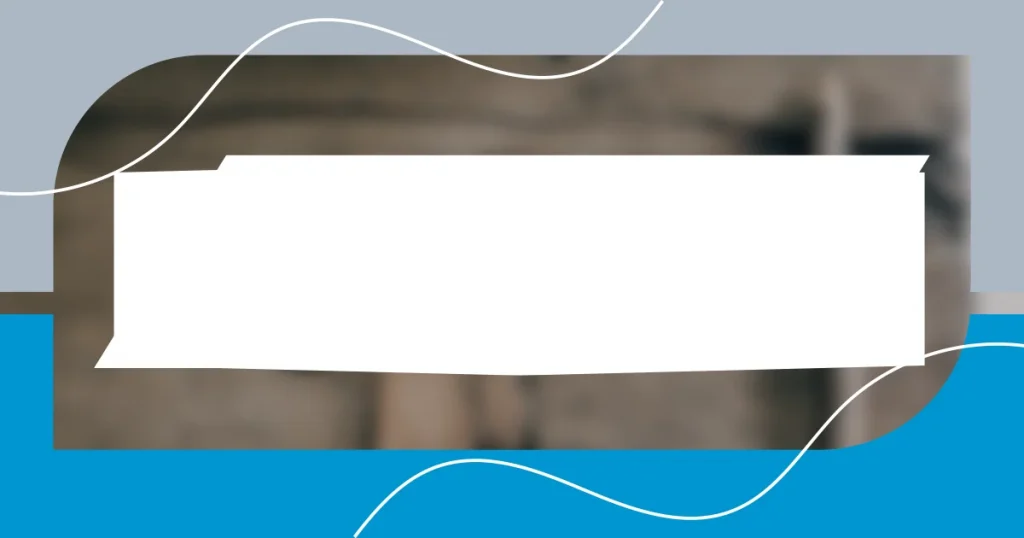Key takeaways:
- Understanding curing finishes is vital for enhancing aesthetics and durability in woodworking projects.
- Choosing the right type of finish (oil, lacquer, polyurethane) significantly impacts the appearance and longevity of the piece.
- Proper curing techniques, such as controlling the environment and applying multiple thin coats, are essential for achieving flawless results.

Understanding curing finishes
Curing finishes are essential in the world of coatings and surfaces, transforming the raw material into something protective and aesthetically pleasing. I remember the first time I used a curing finish on a woodworking project; the moment it dried, I was struck by how the colors popped and the grain came alive. Have you ever noticed how a well-cured finish can make the difference between a piece that looks ordinary and one that simply dazzles?
The science behind curing finishes mesmerizes me; it’s not just about aesthetics but about longevity too. When I applied a two-part epoxy on my last outdoor piece, I felt a sense of assurance knowing it would withstand the weather. Isn’t it fascinating how this process enhances durability, giving us the confidence to create and use our pieces in various conditions?
Understanding the curing process means appreciating the types of finishes available—like oil, lacquer, and polyurethane. Each offers a unique finish and performance, and choosing the right one can feel daunting. I often ask myself, which finish will resonate with the essence of the piece? Invariably, this choice shapes the story my work presents to the world; choosing wisely is a step toward letting each creation shine.

Types of curing finishes
When exploring the various types of curing finishes, I find it intriguing how each one offers distinct characteristics. For instance, oils penetrate deeply into the wood, enhancing the natural grain with a warm glow. I recall using Tung oil on a project; the way it soaked in, revealing the rich patterns of the wood, was nothing short of magical. On the other hand, lacquers dry quickly and form a hard, protective layer that is great for a high-gloss finish. I remember feeling the excitement of using lacquer on a kitchen table; the reflection it gave off made the surface almost dance in the light.
Polyurethane stands out to me, especially when it comes to durability. I once refinished an outdoor bench using water-based polyurethane, and it held up beautifully against the elements. The finish created a tough barrier that protected the wood without sacrificing clarity. This type of finish can be a game-changer for anyone looking to maintain the look of their wood while ensuring it lasts through the years. Each finish not only serves a purpose but also impacts the final look and feel of the project.
To help you better understand the differences among these finishes, here’s a simple comparison table:
| Type of Finish | Characteristics |
|---|---|
| Oil | Pentrates wood, enhances grain, warm finish |
| Lacquer | Dries quickly, forms hard layer, glossy finish |
| Polyurethane | Durable, water-resistant, maintains clarity |

Importance of proper curing
Proper curing is vital for achieving the best possible results in any project involving finishes. I’ve learned this firsthand; skipping or rushing the curing stage can lead to a finish that either peels off or looks uneven, leaving the piece devoid of its intended beauty. There’s a striking sense of satisfaction that comes from watching the finish cure properly, knowing that I’ve invested time and care into my work—and that the results will reflect that dedication.
Here are a few reasons why proper curing is crucial:
- Durability: A well-cured finish forms a strong barrier, protecting surfaces from wear and tear.
- Aesthetics: It enhances color and texture, elevating the overall look of the piece.
- Adhesion: Ensures the finish bonds effectively, preventing peeling or chipping over time.
- Resistance: Provides greater resistance against environmental factors like moisture and UV rays.
- Longevity: Extends the life of the finish, reducing the need for frequent reapplications.
In reflecting on my experiences, I’ve found that the anticipation of a finish curing can be almost like waiting for a fine wine to breathe. I remember the times I’ve had to resist the urge to touch a freshly applied coat, knowing that the waiting game would ultimately reward me with a flawless surface. That moment of unveiling, revealing a beautifully cured finish, has proven time and again to be one of the most gratifying aspects of my craftsmanship. The right cure not only protects but transforms the piece into something extraordinary.

Techniques for curing finishes
One effective technique I often employ for curing finishes is the use of controlled temperature and humidity. I vividly recall a project where I applied Danish oil in a humid environment. Initially, I underestimated the impact of moisture, resulting in a longer drying time than anticipated. By moving the piece to a climate-controlled area, I could see a drastic improvement in the curing process. Have you ever thought about how much the environment influences your finish? It’s incredible how minor adjustments can lead to stunning results.
Another technique that has served me well is utilizing a heat source, like a heat lamp, to accelerate curing. I remember experimenting with this approach on a small side table I crafted. With the lamp positioned strategically above the finish, I watched in awe as it hardened beautifully in less than half the usual time. It felt almost like magic, transforming a waiting game into a quick marvel. I encourage you to consider how such tools can make your own finishing tasks more efficient and rewarding.
Lastly, I find that applying multiple thin coats instead of one thick layer can make a significant difference in curing. In my early days of woodworking, I made the mistake of slapping on a heavy coat of finish, only to be met with bubbling and inconsistency on the surface. I’ve since learned that patience is key; building up the finish gradually not only enhances the quality but also allows each layer to cure properly. Isn’t it fascinating how a little care can elevate the entire piece? It’s one of those lessons that has genuinely made me appreciate the journey of every project I undertake.

Common issues with curing
Curing finishes can present a few common issues that can derail even the best of projects. For instance, I once encountered what I affectionately call “the tacky finish fiasco.” After applying a fresh coat of varnish to a bespoke bookshelf, I assumed the room’s temperature was reasonable. However, a sudden drop in temperature left the finish feeling sticky for days. This taught me just how sensitive finishes can be and how easy it is to overlook environmental variables. Have you ever had a project go awry because of something you thought was minor?
Another significant issue I’ve faced is the dreaded orange peel effect. I vividly recall working on a beautiful coffee table when I noticed the surface had developed an unsightly texture reminiscent of an orange skin. I realized that my spray technique had been off; I was applying too thick a coat too quickly. It felt disheartening, but it was a crucial lesson in finesse. I now make it a point to practice a smooth and consistent technique to ensure each layer cures evenly.
Then there’s the challenge of dust becoming an unwelcome guest on a freshly cured finish. I’ve spent hours diligently sanding and polishing only to find that a little dust had settled while the finish was curing. This experience was frustrating, to say the least! I learned to cover my projects with a clean cloth while awaiting curing, creating a mini sanctuary for my piece. Have you ever felt like the universe was conspiring against your craftsmanship? It’s moments like these that remind me that patience and preparation can truly save the day.

Tips for successful curing
When it comes to successful curing, timing is absolutely critical. I still vividly remember a time I miscalculated the drying time during a warm summer day, thinking I could rush the process. The result? A beautiful finish turned into a smudged disaster due to my impatience. Have you ever seen a promising project go south because you jumped the gun? It’s a gentle reminder to give your finishes the time they need to bond properly.
Keeping a close eye on the curing environment is another key to success. I often check the temperature and humidity levels before starting a project. I recall working on a dining table in a less-than-ideal space, where humidity levels spiked unexpectedly. The finish didn’t cure right, leaving an uneven sheen that I couldn’t stand. It taught me that a simple dehumidifier can be a game changer in ensuring consistent results. So, how do you prepare your workspace for finishing?
Lastly, I recommend approaching curing as a meditative process. When I’m waiting for the finish to cure, I take that time to reflect on what I’ve learned and how I can improve. It’s almost like nurturing a plant – the more care and attention I give it, the more rewarding the results. Did you know that some finishes can take days to cure fully? Embracing that waiting game can turn impatience into anticipation, making the final reveal that much sweeter.

Advanced applications of curing finishes
Integrating advanced curing finishes in specialized applications can really elevate a project. I once experimented with UV-cured finishes on a handcrafted guitar, and the results were astonishing. Not only did the finish dry within seconds under the UV light, but it also provided an incredibly durable surface that enhanced the guitar’s beautiful wood grain. It made me wonder: have you considered how technology can transform your finishing techniques?
Moreover, the use of two-part polyurethane finishes in high-traffic areas has become a game changer for me. I remember refinishing a hardwood floor in a busy entryway, and using this advanced finish allowed me to achieve both resilience and aesthetic appeal. The key to success here is the meticulous mixing of the components, which I learned the hard way after an uneven application in an earlier project—definitely something I won’t repeat! How often do we overlook the importance of precise measurements in our crafts?
Lastly, I’ve recently been intrigued by the concept of reactive finishes, especially in restoration projects. I once revived a vintage wooden cabinet using a reactive oil that not only sealed the wood but also transformed its appearance in ways I didn’t expect. The way the finish interacted with the existing patina was magical! Have you ever thought about how using advanced finishes can breathe new life into tired pieces? It’s all about matching the right applications to the right project for transformative results.
















